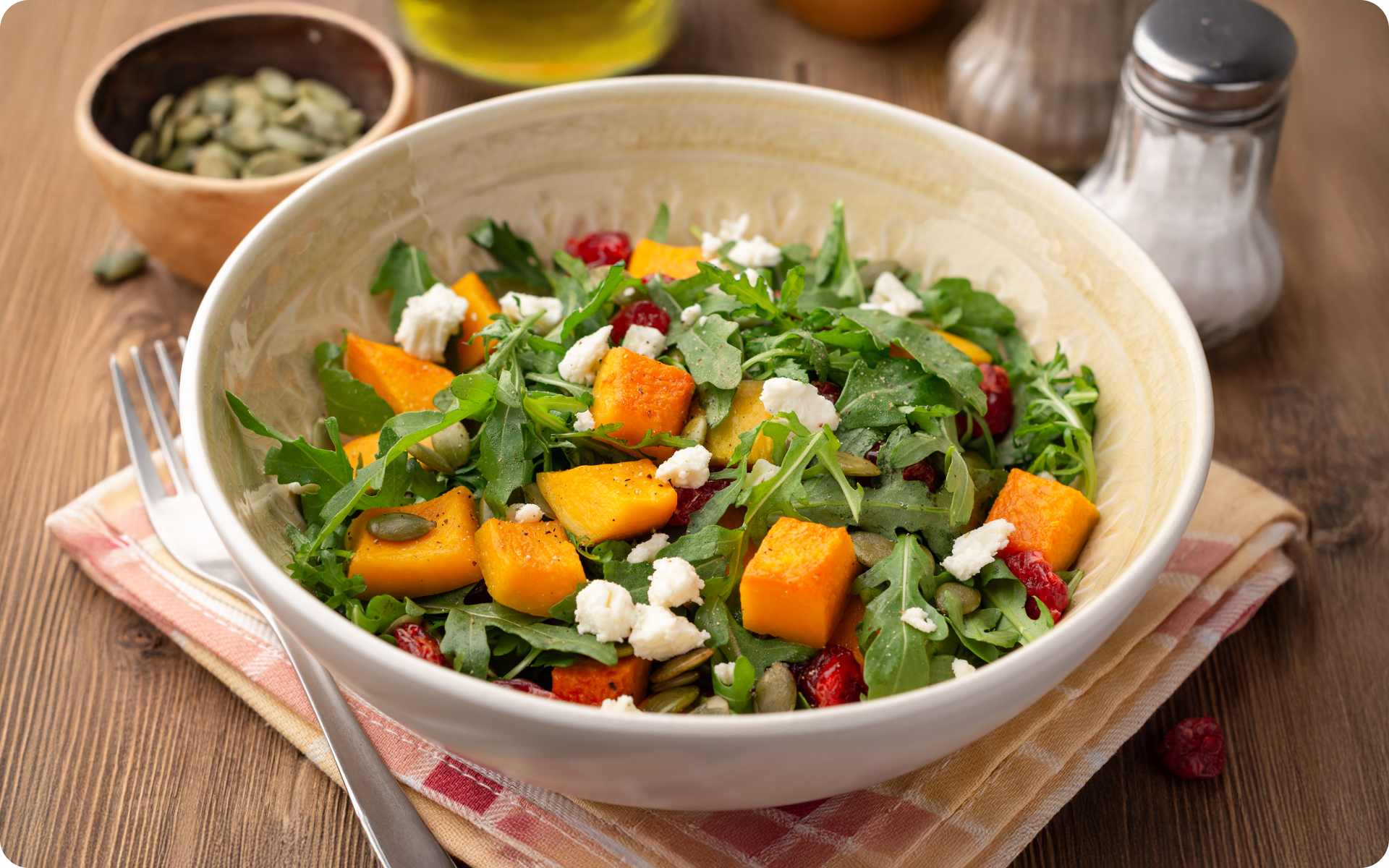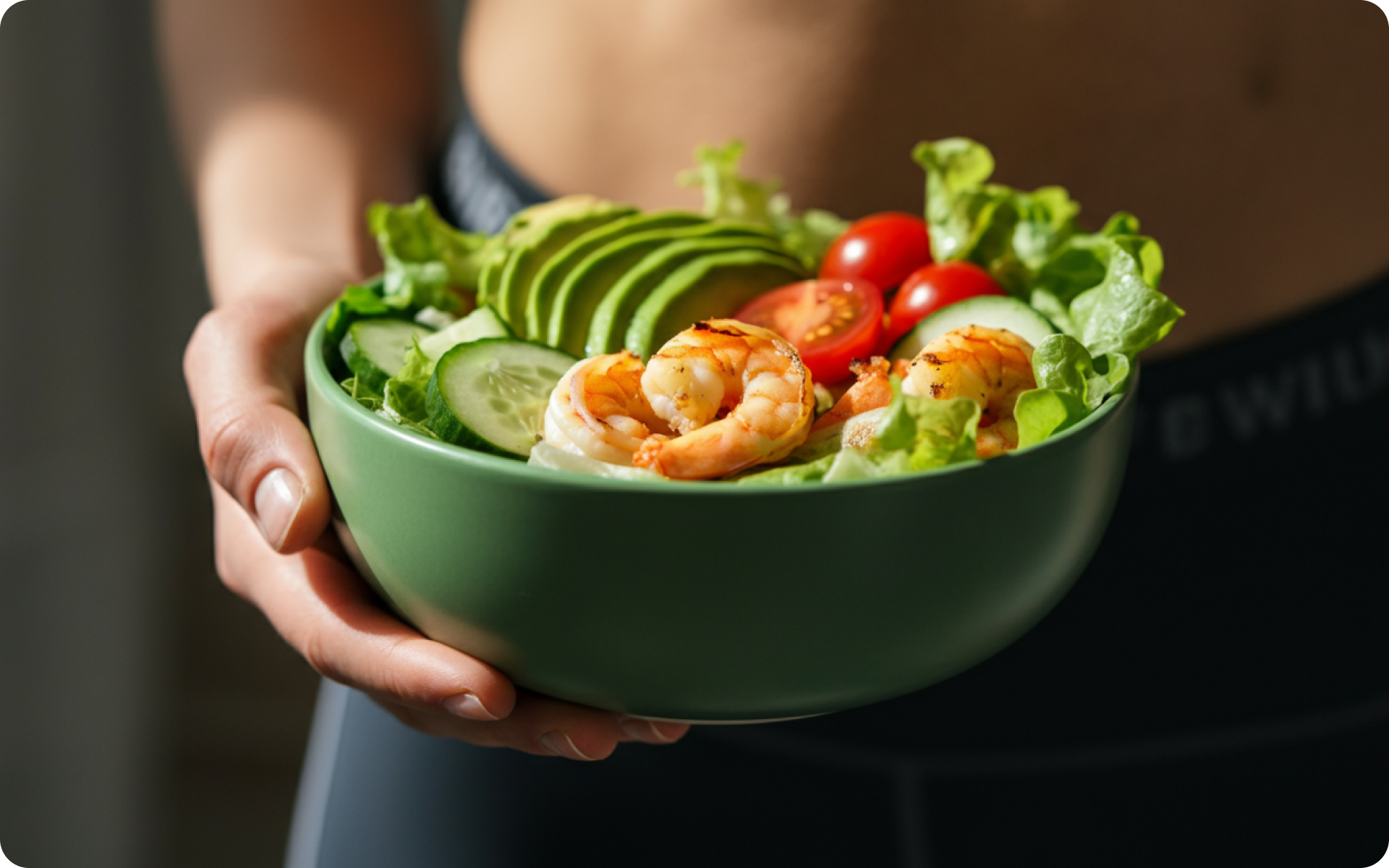What Is a Balanced Diet?
A balanced diet is a nutrition pattern that provides your body with all the essential nutrients it needs to function properly. This eating approach is geared toward improving your overall health and guarding you against disease. A healthy lifestyle consisting of a balanced diet and regular exercise can help reduce the risk of chronic diseases such as obesity, cardiovascular disease, diabetes, high blood pressure, and cancer (4, 3).
According to the USDA’s recommendations, approximately half of your plate should contain fruits and vegetables. Whole grains and lean protein should also be included in your nutrition plan, in addition to low-fat dairy, nuts, and legumes (5).
Why Is it Important to Eat a Balanced Diet?
Many people believe that following a healthy balanced diet is far too demanding and cumbersome, but adhering to a balanced eating approach has a whole plethora of advantages that you should pay heed to:
- Decrease harmful LDL cholesterol and optimize blood pressure. Hypertension and high cholesterol levels are among the leading risk factors for heart disease worldwide. Following a diet that is high in animal fats and salt promotes weight gain and may also have a negative impact on your heart health, risk of certain cancers, and all-round well-being.
- Rejuvenate skin. Eating healthy foods can help minimize acne, reinforcing your skin’s barrier, which will keep moisture in and irritants out and create a natural healthy glow.
- Increase your energy levels. Many people complain about feeling tired 24/7 and grappling with chronic fatigue. One reason for low energy levels is poor nutrition. If you often feel extremely drowsy and ready to drop, regardless of how long you slept, try to follow a healthy balanced diet. It should fire up your energy levels and make you feel better.
- Improve heart health. Another reason to start eating well is to improve your heart health. Make sure to include whole grains, vegetables, and fruits, while also reducing added sugar, salt, and saturated fat intake to reduce your risk of heart disease.
- Help maintain a healthy weight. Healthy weight is one of the most common reasons why many people decide to make a healthy choice and switch to a healthy diet. A healthy weight means fewer health problems and a lower risk of developing diabetes and heart disease.
Betterme will keep you laser-focused on your weight loss journey! Nutrient-packed meal plans, fat-blasting workouts, galvanizing challenges and much more. Try using the app and see for yourself!
How to Eat a Balanced Diet
Following proper nutrition will help with weight loss and health improvement and will get you one step closer to achieving a well-adjusted life. Here are some basic principles of healthy nutrition that everyone should know:
- Foods to limit include fast food, fried foods, and sugary foods and beverages. Instead, load your plate with vegetables, fruit, lean proteins, whole grains, and legumes. In other words, stick to food that packs a nutritional punch.
- Eat as many seasonal foods as possible – they are loaded with nutrients and are cheaper.
- Try to eat more whole grains. Refined grain products don’t have much fiber – a nutrient that’s essential for proper digestive function. Try swapping your usual white bread or pasta for whole-wheat versions, and experiment with other whole grains such as quinoa, oats, buckwheat, and brown or wild rice.
- Keep your fluid intake up. You can estimate your fluid needs at around 30–35 ml of fluid per 1 kg of weight per day. All fluids count, but it’s best to limit sugary beverages and alcohol. Caffeine in moderation is okay, but don’t allow it to affect your sleep quality.
- Don’t forget about protein foods. They give you a feeling of satiety for a long time and are also a source of essential amino acids. Proteins are necessary for the body to build muscle tissue, and perform countless other functions. Protein-rich foods include various types of meat, fish, other seafood, beans and legumes, nuts and seeds, eggs, and dairy products.
- Eat a variety of different foods, so you’ll get all the nutrients that are important for your overall health.
- Don’t starve yourself. Eat 3 main meals throughout the day and choose healthy snacks if you’re still hungry.
What Does a Balanced Diet Look Like?
Make sure you incorporate these healthy foods into your diet every day:
- Whole grains are rich in slow carbs, which will boost your energy levels
- Fresh vegetables such as cabbage and carrots provide your body with dietary fiber
- Legumes are rich in vegetable protein
- Nuts (such as walnuts and almonds) have a beneficial effect on the entire body and are a source of protein, fiber, healthy fats, vitamins, and minerals.
- Dairy products: natural yogurts (without added sugar), kefir, and low-fat cottage cheese provide calcium and protein, while some contain probiotics
- Sea fish contains protein and essential omega-3 fatty acids
- Fruits and berries are a storehouse of vitamins – they can help improve your skin and protect the body from inflammation and disease
- Lean meat such as chicken breast, pork, and beef are excellent sources of protein
If you want to hit a certain weight loss target, it’s also helpful to limit added sugar.
What Drinks Are Good for a Balanced Diet?
- Pure or flavored (not sweetened) water or sparkling water
- Unsweetened black coffee or caffeinated tea in moderation
- Unsweetened herbal tea
Foods to limit or avoid:
- Sugary drinks
- Deep-fried foods
- Processed meats
- Ultra-processed snacks and sweets
- Alcohol
Read more: 7-Day Weight Loss Low-Carb Diet: Choose High-Protein, High-Fiber, or Ultra-Low-Carb
How to Achieve a Balanced Diet
It’s not that easy to completely get out of your comfort zone in one day. But what if you give yourself a week or so to get used to the new rules? Remember, changing any kind of habit is work, and you should make big changes with little steps. Here are some useful tips that will help you make healthy changes to your eating habits:
Keep a food journal
By tracking what you eat and drink you will be able to evaluate your diet and see where there is room for improvement.
Don’t skip breakfast.
This is the most important meal of the day – after fasting all night, your body needs calories and breakfast helps the body wake up. It can amp up your energy levels, and provide fuel for your brain so you can focus and be productive. Breakfast should include complex carbohydrates, fiber, protein, and healthy fats. Some of the best breakfast foods are fruits and vegetables, whole-grain cereals or bread, lean meats, high-protein dairy products, avocados, nut butters, and eggs.
Add, don’t subtract
Focus on what nutritious foods you can add to your diet rather than what you think you need to remove or avoid. The goal is to eat mostly healthy, nutritious foods in a balanced way, so start by adding more fruits, vegetables, whole grains, beans, or whatever it is you may not eat enough of.
Snack smart
Snack on nuts, fruits, and vegetables, and other nutritious but convenient foods instead of chips or crisps, chocolate bars, sweets, etc.
Always carry a bottle of water with you everywhere
Water is essential for metabolism and helps carry nutrients to cells. Adopt the habit of putting a bottle of water in your bag in the morning, no matter where you’re going.
Make a grocery list
When you go to the supermarket, make sure you’ve prepared a list beforehand. People tend to put more food in their basket than they need. Don’t go to the supermarket on an empty stomach as this habit could lead to you buying things you don’t really want.
Cut down on added sugar
For overall health, it’s generally recommended to get less than 10% of your calories from added sugar.
What Does a Balanced Diet Sample Menu Look Like?
A balanced diet plan will help you develop a habit of eating right. You should take your lifestyle into account when creating a meal plan for a week or month. Here’s a sample balanced diet menu that may be helpful for you.
Monday
- Breakfast: rice pudding with nut butter, one banana or one apple, black coffee.
- Snack: whole-grain bread, boiled egg, tomato.
- Lunch: steamed mackerel, cabbage salad with peas and sunflower oil.
- Snack: low-fat cottage cheese with a spoonful of 10% sour cream, green apple, and a cup of tea.
- Dinner: beef pot roast with vegetables and mashed potatoes.
Tuesday
- Breakfast: a slice of whole-grain bread, creamy cottage cheese, cucumber, grapes, and coffee or tea.
- Snack: cottage cheese with a teaspoon of honey.
- Lunch: lentil soup, fresh salad with cabbage, cucumber, and tomato seasoned with lemon juice.
- Snack: red apple and one kiwi, green or herbal tea.
- Dinner: lean beef and vegetable stir-fry, rice.
Wednesday
- Breakfast: oatmeal with peanut butter and raisins, a spoonful of honey, and unsweetened coffee.
- Snack: walnuts, green apple, tea, lemon.
- Lunch: brown rice, stir-fried vegetables, and chicken.
- Snack: cottage cheese with sliced bell peppers, herbal tea.
- Dinner: baked fish, rice pilaf, green salad.
Thursday
- Breakfast: oatmeal in milk, fresh raspberries, blackberries, blueberries, or strawberries.
- Snack: fat-free unsweetened yogurt, a teaspoon of honey, and black coffee.
- Lunch: baked tofu, quinoa, and vegetable salad.
- Snack: salad with tomatoes and cucumbers, tossed with low-fat sour cream.
- Dinner: baked chicken without skin, sprinkled with parmesan, whole-wheat pasta with marinara sauce, cucumber salad.
Friday
- Breakfast: mashed potatoes, butter, one boiled egg, one cucumber.
- Snack: green tea and two kiwis.
- Lunch: mushroom soup with pearl barley, a slice of whole-wheat bread or crackers, and cheese.
- Snack: cottage cheese with berries.
- Dinner: baked fish, seaweed salad, and rice.
Saturday
- Morning meal: whipped omelet from two eggs, cheese, vegetables, and freshly brewed black coffee.
- Snack: grapefruit or pomelo.
- Lunch: baked potatoes with mushrooms, baked chicken.
- Snack: kefir or low-fat yogurt, one green apple.
- Dinner: tofu and cauliflower curry with rice.
Sunday
- Morning meal: millet porridge with butter, a glass of black tea without sugar.
- Snack: kiwi and banana.
- Lunch: steamed vegetable and orzo casserole, air-fried chicken filet.
- Snack: hard-boiled eggs.
- Dinner: steamed fish cake, rice, tomato salad.
BetterMe app will kick you out of the mental funk, shake off your extra weight, rid you off your energy-zapping habits, and help you sculpt the body of your dreams. Intrigued? Hurry up and change your life for the better!
Does a Balanced Diet Help with Weight Loss?
A balanced diet can promote weight loss as it can help reduce calorie intake while meeting all your nutritional needs and helping you feel satisfied. However, increasing physical activity, getting enough sleep, and managing stress are also important.
Although a healthy nutrition plan can help you maintain a healthy weight, studies have shown that weight-loss strategies must be individualized (2). However, the weight loss results may vary from person to person depending on sex, age, and genetics. Moreover, research has suggested that behavioral, psychological, social, and socioeconomic factors also play roles in weight loss.
Can Vegetarians Have a Balanced Diet?
A vegetarian nutrition plan can be healthy and balanced. It may also help reduce the risk of certain health conditions. However, you should be extra careful when following a vegetarian meal plan as this eating pattern eliminates certain foods. A balanced vegetarian diet should include a variety of fruits, vegetables, nuts and seeds, whole grains, legumes, and soy products in your routine to get enough nutrients. In addition, vegetarians sometimes need to supplement their diet to get enough protein, iron, calcium, vitamin D, vitamin B12, and omega-3 fatty acids.
Why Is it So Hard to Eat Healthy?
Everyone has felt the burden of not being able to eat healthily at some point in their lives. Eating the right food can be challenging due to a combination of biological, environmental, and psychological factors. Here’s why it can be tough to stick to healthy eating habits:
Biological Factors:
Our bodies are hardwired to crave high-calorie foods for survival. This can make ultra-processed foods that are high in sugar and fat more appealing than nutrient-dense options. (7)
Environmental Influences:
- Accessibility: Healthy foods are sometimes less accessible and more expensive than ultra-processed options, especially in places where fresh produce is scarce.
- Social Settings: Social gatherings often revolve around food that may not be the healthiest, which makes it more difficult to choose nutritious options.
Psychological Aspects:
- Habit: Unhealthy eating habits formed over the years are usually incredibly hard to break.
- Stress and Emotional Eating: People often turn to comfort foods in times of stress, which are typically high in sugar, salt, and fat.
- Misinformation: The abundance of conflicting nutritional information can make it difficult to know what eating healthily truly means, which leads to confusion and poor dietary choices.
Overcoming these challenges requires a comprehensive approach, including education on nutrition, improving access to healthy foods, and developing strategies to keep stress-induced and emotional eating at bay.
Read more: 24 Weight Loss Smoothies, 2 Diet Plans, and 5 Belly Fat Smoothie Secrets
FAQs
What happens if you don’t have a balanced diet?
Not maintaining a balanced diet can lead to a variety of health issues due to nutrient deficiencies and imbalances. This path may lead you toward the following problems:
- It can cause nutritional deficiencies such as the lack of essential vitamins and minerals, which can lead to conditions such as anemia (from lack of iron) and other deficiencies. (8)
- It can increase the risk of chronic diseases such as heart disease, diabetes, and osteoporosis due to weight gain from the overconsumption of unhealthy fats, sugars, and salt.
- It can deteriorate the immune function of the body. Poor nutrition weakens the immune system, which makes the body more susceptible to infections and illnesses.
- An imbalanced diet can affect energy levels and mood, contributing to fatigue and an increased risk of mental health issues such as depression and anxiety. (6)
A balanced diet is essential for maintaining overall health and preventing long-term health problems.
Is there a perfect diet?
There is no single “perfect” diet that suits everyone due to individual variations in genetics, lifestyle, cultural background, socioeconomic factors, and health needs. The most effective diets share common traits:
- Diversity: It’s important to incorporate a wide range of foods to ensure a comprehensive intake of nutrients.
- Moderation: Make sure you balance your calorie intake with physical activity and avoid excessive consumption or elimination of any single food group.
- Whole Foods: Emphasize whole, minimally processed foods that are rich in nutrients over ultra-processed foods that are high in added sugars and unhealthy fats.
Finding the right diet involves considering personal health goals, preferences, and nutritional needs.
What are the four types of balanced diet?
A balanced diet typically includes four key food groups, each of which provides essential nutrients:
- Proteins: Vital for building and repairing tissues. Sources include meat, fish, eggs, dairy, legumes, seeds, and nuts.
- Fruits and Vegetables: Rich in vitamins, minerals, fiber, and antioxidants. Aim for a variety of colors to maximize nutrient intake.
- Grains: Source of energy and fiber. Whole grains (such as whole wheat, brown rice, and oats) are preferred over refined grains.
- Dairy or Alternatives: Important for calcium and vitamin D. Includes milk, cheese, yogurt, or plant-based alternatives fortified with these nutrients. (1)
The Bottom Line
While most of us have heard the term “balanced diet”, it isn’t as simple to inculcate it into our regular eating. Years of eating unhealthy food, misinformation, and a variety of reasons influence why we’ve been unable to do this, despite knowing about the benefits of the diet. In this article, we’ve addressed what a balanced diet contains, how to systematically introduce it into your routine, and provided sample meal plans for you to consider. Following our guide will help you reap all the benefits of a balanced diet and it may also change your life and fitness levels forever.
DISCLAIMER:
This article is intended for general informational purposes only and does not serve to address individual circumstances. It is not a substitute for professional advice or help and should not be relied on for making any kind of decision-making. Any action taken as a direct or indirect result of the information in this article is entirely at your own risk and is your sole responsibility.
BetterMe, its content staff, and its medical advisors accept no responsibility for inaccuracies, errors, misstatements, inconsistencies, or omissions and specifically disclaim any liability, loss or risk, personal, professional or otherwise, which may be incurred as a consequence, directly or indirectly, of the use and/or application of any content.
You should always seek the advice of your physician or other qualified health provider with any questions you may have regarding a medical condition or your specific situation. Never disregard professional medical advice or delay seeking it because of BetterMe content. If you suspect or think you may have a medical emergency, call your doctor.
SOURCES:
- Balanced Diet (2023, healthline.com)
- Essentials of Healthy Eating: A Guide (2012, ncbi.nlm.nih.gov)
- Healthy lifestyle factors in the primary prevention of coronary heart disease among men: benefits among users and nonusers of lipid-lowering and antihypertensive medications (2006, ncbi.nlm.nih.gov)
- Preventing cancer, cardiovascular disease, and diabetes: a common agenda for the American Cancer Society, the American Diabetes Association, and the American Heart Association (2004, ncbi.nlm.nih.gov)
- Prevention of Overweight and Obesity: How Effective is the Current Public Health Approach (2010, ncbi.nlm.nih.gov)
- Symptoms of Not Eating (2023, verywellhealth.com)
- The 2015–2020 Dietary Guidelines for Americans ( 2015, choosemyplate.gov)
- 7. What are the signs of not eating enough? (2019, medicalnewstoday.com)










